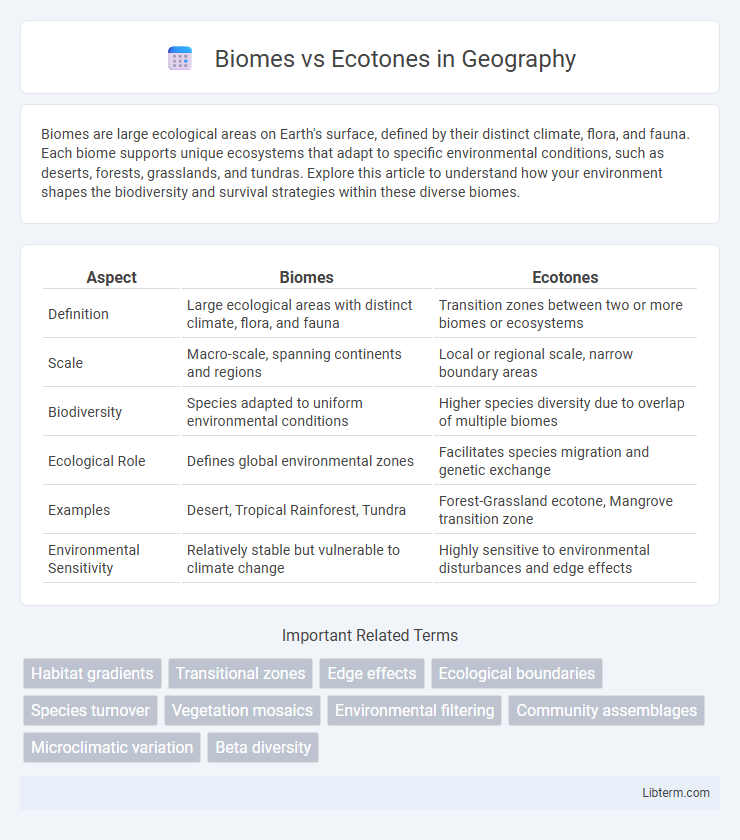Biomes are large ecological areas on Earth's surface, defined by their distinct climate, flora, and fauna. Each biome supports unique ecosystems that adapt to specific environmental conditions, such as deserts, forests, grasslands, and tundras. Explore this article to understand how your environment shapes the biodiversity and survival strategies within these diverse biomes.
Table of Comparison
| Aspect | Biomes | Ecotones |
|---|---|---|
| Definition | Large ecological areas with distinct climate, flora, and fauna | Transition zones between two or more biomes or ecosystems |
| Scale | Macro-scale, spanning continents and regions | Local or regional scale, narrow boundary areas |
| Biodiversity | Species adapted to uniform environmental conditions | Higher species diversity due to overlap of multiple biomes |
| Ecological Role | Defines global environmental zones | Facilitates species migration and genetic exchange |
| Examples | Desert, Tropical Rainforest, Tundra | Forest-Grassland ecotone, Mangrove transition zone |
| Environmental Sensitivity | Relatively stable but vulnerable to climate change | Highly sensitive to environmental disturbances and edge effects |
Definition of Biomes
Biomes are large ecological areas on Earth's surface characterized by distinct climate conditions, flora, and fauna, such as deserts, tundras, and rainforests. These major ecosystems are defined by patterns of temperature, precipitation, and soil types, supporting specific communities of plants and animals adapted to those environments. Understanding biomes is crucial for studying global biodiversity, climate impact, and conservation strategies.
Definition of Ecotones
Ecotones are transitional zones where two or more biomes or ecosystems converge, creating a unique area with high biodiversity and species interactions that differ from the adjacent biomes. These regions often exhibit edge effects, where environmental conditions and species compositions blend, resulting in increased ecological variation and complexity. Unlike biomes, which are large-scale ecological classifications based on climate and vegetation, ecotones represent the dynamic boundaries that influence species distribution and ecosystem processes.
Key Differences Between Biomes and Ecotones
Biomes represent large-scale ecological zones characterized by uniform climate, vegetation, and wildlife, while ecotones are transitional areas connecting two or more biomes, featuring unique species from each. Biomes typically maintain stable environmental conditions, whereas ecotones exhibit greater biodiversity and ecological gradients due to the overlap of habitats. The spatial scale of biomes is vast and generalized, contrasting with ecotones' localized and dynamic nature influenced by edge effects and environmental fluctuations.
Types of Biomes
Biomes are extensive ecological zones characterized by specific climate conditions and distinct plant and animal communities, including types such as tropical rainforests, deserts, tundras, grasslands, and temperate forests. Each biome supports unique biodiversity adapted to its temperature, precipitation, and seasonal variations. In contrast, ecotones represent transitional areas between two biomes, often exhibiting a mixture of species from both adjoining ecosystems and heightened ecological interactions.
Types of Ecotones
Ecotones represent transitional zones where two or more biomes converge, exhibiting characteristics of each adjacent ecosystem while supporting unique species adapted to the mix of conditions. Types of ecotones include edge ecotones, which occur between forests and grasslands, riparian ecotones found along waterways linking aquatic and terrestrial biomes, and marine-terrestrial ecotones such as coastal salt marshes where ocean meets land. These ecotones enhance biodiversity, create microhabitats, and act as natural buffers influencing ecological processes and species interactions.
Ecological Roles of Biomes
Biomes serve as extensive ecological zones characterized by dominant vegetation types and climate conditions, playing critical roles in global carbon storage, oxygen production, and habitat provision for diverse species. They regulate Earth's energy balance by influencing temperature and precipitation patterns, thus maintaining ecosystem stability and resilience. These large-scale ecological units support nutrient cycling and food webs that are essential for sustaining biodiversity and human livelihoods.
Ecological Functions of Ecotones
Ecotones serve as critical transitional zones between distinct biomes, supporting increased biodiversity and ecological productivity by integrating species from adjacent ecosystems. These areas function as natural buffers that enhance nutrient cycling, water filtration, and serve as habitats for unique species that thrive in edge environments. Ecotones also facilitate species migration and genetic exchange, promoting resilience and adaptation in response to environmental changes.
Species Diversity in Biomes vs Ecotones
Species diversity in biomes typically reflects broad-scale environmental conditions supporting large, stable populations of specialized flora and fauna adapted to uniform habitats. Ecotones, as transitional zones between two or more biomes, exhibit higher species diversity by harboring species from adjoining biomes plus unique organisms adapted to edge conditions and variable microhabitats. This increased biodiversity in ecotones enhances ecosystem resilience and ecological interactions due to the convergence of multiple communities.
Human Impact on Biomes and Ecotones
Human activities significantly alter biomes through deforestation, urbanization, and agriculture, leading to habitat loss and biodiversity decline. Ecotones, as transitional zones between biomes, are particularly sensitive to environmental changes and experience intensified stress from pollution and land conversion. Conservation efforts targeting both biomes and ecotones help maintain ecological balance and preserve essential ecosystem services.
Importance of Preserving Biomes and Ecotones
Preserving biomes and ecotones is critical for maintaining biodiversity, ecosystem stability, and resilience against climate change. Biomes support vast arrays of species adapted to specific climate conditions, while ecotones serve as unique transition zones that harbor species from adjoining biomes, often exhibiting higher species richness and ecological interactions. Protecting these areas ensures ecosystem services such as carbon sequestration, water filtration, and habitat connectivity remain intact, promoting overall environmental health and sustainability.
Biomes Infographic

 libterm.com
libterm.com